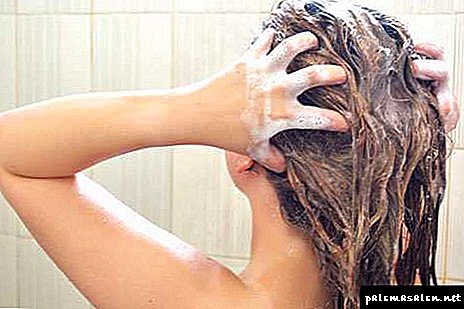In order to determine the type and diagnosis of the scalp, it is necessary to take into account that changes are constantly changing in the body, and with this the condition of the hair and skin changes. It depends on the environment and on the products that people consume. In many large cities that have increased pollution, hair quickly becomes dirty and dull.
Main types
The following skin types are distinguished.:
- Normal mainly occurs in children and the minimum number of adults. An important feature is its elasticity. People who have this type do not know the problems with it. On the skin do not appear red spots, acne, pimples. She perfectly tolerates any weather phenomena such as frost or windy weather and also not be afraid of hot weather. After washing the head, it does not peel off, does not tighten.
Owners of this species should not be particularly relaxed and also take care of it. After all, a lot of negative factors can change its structure and lead to a painful mind.
But there are disadvantages, for example, fine wrinkles, which appear rather early, are characteristic of it. After washing with soap, it “tightens”. Outside in windy weather begins to peel off and blush. In general, this is the most sensitive skin type that reacts to external stimuli painfully. She needs the right care, without him she will look sad.  Fatty occurs in many individuals, especially it begins to manifest itself during puberty. It has a color that is not quite attractive, mostly yellow or gray. Oily skin has enlarged pores, which gives it an oily tint. Purulent acne can form on it, acne is especially noticeable during puberty. It is considered the most problematic and does not look very neat to others.
Fatty occurs in many individuals, especially it begins to manifest itself during puberty. It has a color that is not quite attractive, mostly yellow or gray. Oily skin has enlarged pores, which gives it an oily tint. Purulent acne can form on it, acne is especially noticeable during puberty. It is considered the most problematic and does not look very neat to others.
There are also advantages. This type of moisture retains quite well and due to this, the skin retains its elasticity for a long time. Wrinkles appear much later than in other skin types.
You can find out more about the scalp here https://vsemugolova.com/bolezni/kozhi.
Hairline options
There are the following types of hair:
- Dry most often they do not have luster and their tips constantly split. This happens due to improper care. And with a competent approach to them, they are restored. This type of hair should not be permanently dyed, and it is better to feed them with useful vitamins. It is recommended to wash them once a week, but the use of various masks is welcome.
- Fat type pretty quickly polluted. Plus for women is to create a beautiful hairstyle, the hair is easy to stick to the hairstyle and it remains for a long time. It is recommended to use shampoos for oily hair, which will strengthen their structure and give them extra shine and volume.
- Mixed type It is considered when the roots have a fat appearance, and the tips are vice versa dry. This is due to the fact that the fat produced is not distributed to the entire hair. It is recommended to wash once a week.
How to determine?
 To determine the type of hair, you can use a special test.:
To determine the type of hair, you can use a special test.:
- You must first conduct a fat test. To do this, you need a napkin or paper towel.
- Take a strand and wash it with shampoo several times, then dry with a napkin and leave to dry completely.
- In the future, consider this cloth, if it has sebaceous manifestations, then you have oily hair. But if there is no trace left on the napkins, then the hair belongs to the dry, normal and combined type.
With the help of such observations, the type of hair at home is simply determined.
Care Tips for Everyone
Human health has a big impact on hair type. and on the condition of the scalp.
- It is important to follow the diet and eat only healthy foods that contain sufficient amounts of vitamins and minerals. And about the rules of nutrition of the scalp, you can find out by clicking here https://vsemugolova.com/bolezni/kozhi/pitanie-k-golovy.html.
- It is also recommended to drink as much liquid as possible.
- To avoid bad habits such as smoking and alcohol, they negatively affect the entire body.
- In the hot season it is worth wearing a hat, it will protect your hair from drying out and brittleness.
A healthy lifestyle will contribute to the proper functioning of the whole organism. The main thing is to monitor your health and choose the right care products. Then the scalp and hair will be healthy.
What are the types of hair
An essential condition for proper care at home for the head of hair is the knowledge of their own type. Selection of masks, conditioners and shampoos should be selected taking into account individual characteristics in order to avoid causing harm to curls.

It is easy to determine the type of hair using the test below in the article. Hair in women and men differ in the following parameters:
- fat content (mixed, normal, fat, dry),
- density (thick, thin, medium),
- elasticities (wavy, straight, curly).
Attention! A slight modification of the type of curls can provoke changes in climatic conditions and health, as well as improper care. Changing the fat content and appearance of the strands.
As the hair is healthy and lifeless.
By fat
The secretion of sebum depends on the work of the sebaceous glands of the root zone. The intensity of secretions in some people varies throughout life and due to exposure to certain cosmetics, such as shampoos and hair dyes.
With insufficient secretion by the glands, the skin becomes dry. Stable fat production is characteristic of the normal type, and increased segregation is for the fat type. There is also the fourth type of hair - combined.
Normal
 Owners of this type of curls almost do not encounter difficulties in the care. However, not always a healthy appearance and strength means that the strands do not require careful attention. Characteristic features of the normal type:
Owners of this type of curls almost do not encounter difficulties in the care. However, not always a healthy appearance and strength means that the strands do not require careful attention. Characteristic features of the normal type:
- elasticity,
- easy combing
- easy installation
- the lack of tip inclination to cross section
- slight dryness (sometimes manifested),
- good moistening of the root zone,
- no peeling of the skin,
- when washing with appropriate shampoo, there is no feeling of skin tightness,
- independent and easy recovery after exposure to coloring compositions and other factors.
Important! It is enough to clean the hair with the help of 2-3 washing procedures per week. Any cosmetic should contain the mark “for normal hair”. To maintain health, weekly masks with nourishing and moisturizing properties (cooked on their own or purchased) are recommended.
Chamomile decoction has a beneficial effect on the normal type of curls. A glass of boiling water need to pour a handful of flowers of the plant (2 tbsp. L) and insist for 30 minutes. Regular trimming (1 time in 2 months) will save the ends of the strands from sections.
The second problematic type of hair after fatty type. Usually, the hairs and scalp themselves are characterized by dryness, with the result that symptoms such as dandruff, inflammation, itching, peeling and irritation appear.
Huge damage, coloring procedures and weather factors cause enormous damage to such a head of hair. Improper care also affects in many respects, especially the wrong choice of cosmetics.
 Characteristic features:
Characteristic features:
- dullness
- lack of elasticity
- fragility
- tangling and difficult combing, especially after applying shampoo,
- difficult to fit,
- congestion of the ends is clearly expressed,
- tendency to alopecia,
- feeling of tightness and discomfort after washing the hair.
Dryness can be caused by the peculiarities of nature (reduced production of fat), negative effects and an approach to old age. If there were no signs of dryness before, it is necessary to identify and eliminate the cause of such a metamorphosis.
For this you will need:
- Refuse to use thermometers and frequent washing. Chlorinated water is not suitable for the latter, it is better to replace it with filtered or boiled water. Chlorine dries hair very strongly. Several times a day is sprayed on the head with thermal fluid.
- Constantly moisturize the strands with special cosmetics, and in sunny weather apply protective agents with a UV filter. Split ends should be applied with serums, sprays, oils or creams after each wash. About three times a week, you can carry out home treatments using your own hand-made mixtures based on a single aroma or complex. This feed will help speed up the recovery process.
- Headgear should always be worn in a frosty and hot time, as well as in pools, baths and saunas. After bathing in the salty waters of the sea, as well as the lake or river, the strands require thorough washing with a clean and fresh liquid.
- Care products must necessarily be designed for dry hair, because they will provide the best nutrition and hydration due to the increased concentration of active ingredients.
- Staining, straightening and chemical waving are detrimental to curls, so they simply need to be abandoned. Especially detrimental effect of bleaching hair. All the above procedures are too aggressive for overdried strands. If you can not do without a color change, it is preferable to use compositions without ammonia content.
- The diet should include only the right foods: fish, vegetables, fruits, beef, lean poultry, legumes, nuts and cereals. Additionally, at the end of spring and autumn you need to take multivitamin complexes. The volume of clean water consumed should not be below the minimum mark of one and a half liters.
- Combing is permissible with a comb made of wood with sparse teeth. Metal is traumatic for the hair structure. Wet hair is absolutely impossible to comb.
- Haircut with the help of hot scissors will allow you to solder the exfoliating ends and will save from further destruction of the structure.
- In winter, in order to avoid exacerbation of dryness due to the effects of heating devices, it is worth artificially to moisten the air in the apartment. This will help ionizer or a conventional bowl of water, which is placed next to the battery.
Attention! If nothing helps to bring dry curls back to life, it is recommended to undergo a comprehensive examination to identify diseases of the internal organs or hormonal failure.
 Fouling appears on the first day after washing. The most problematic type of hair type. Even curls become fat, if there is too much secretion produced by the sebaceous glands.
Fouling appears on the first day after washing. The most problematic type of hair type. Even curls become fat, if there is too much secretion produced by the sebaceous glands.
Hair requires special attention not only for an aesthetic reason, but also because of the frequent manifestations of oilyness due to health problems.
Characteristics of this type of hair:
- sticking of strands
- lack of sections
- oily dandruff
- feeling itchy in the root zone,
- untidy appearance,
- no feeling of tightness after washing,
- volume does not appear even after laying.
Increased fat content is an ideal condition for the active reproduction of harmful bacteria that cause diseases of the epidermis and alopecia.
The most common causes of excessive gassing are:
- hormonal or endocrine disruption,
- disorders of the nervous system,
- worries and stress
- the course of taking certain drugs
- excessive sweating,
- improper diet: increased intake of fat and carbohydrates,
- excessive effort when combing.
To normalize the glands will need to follow a number of recommendations:
- Adjusting the diet. A prerequisite is the reduction of spicy, sweet fried and fatty foods. Instead, you need to increase the consumption of cereals, fruits and vegetables.
- It is necessary to drink filtered water in greater volume.
- It is preferable to wash the hair with room temperature liquid on a regular basis to prevent the active development of harmful bacteria.
- Treatment of hair roots with a permanent will reduce the frequency of washing.
- The method of dry cleansing curls is also effective.
If you choose the right products for fatty strands, you can ensure the extension of the feeling of freshness.
Combined
 The dryness of the curls and the fat content of the skin of the head are the obvious symptoms of this type of hair.
The dryness of the curls and the fat content of the skin of the head are the obvious symptoms of this type of hair.
Characteristic features of the combined curls:
- the root zone is salted 2 days after washing,
- section and breakage of the ends.
Care of such strands complicates the combination of two opposite parameters - greasiness and dryness. Most often, this type is manifested in owners of long curls with an uneven distribution of sebum over the length of the hair.
Attention! Features of the combined head of hair are usually manifested in the springtime, when the wearing of insulated head appliances ends. The roots start to get fat, and the ends after the heating period and freezing weather suffer from brittleness and thinning.
Improper staining, frequent styling with an iron and a hairdryer, as well as chlorinated water are sources of great stress for the hair.
The main recommendation for the care of the combined strands is the refusal to use cosmetics for oily and dry hair. The first type of product provokes even greater dryness of the ends, and the second will cause an increase in sebum production.
The best option is a shampoo, which contains no tar, silicone additives, acids and sulfur. It is worth taking a detergent with jojoba oil, ceramides and silk proteins. Special cosmetics for mixed-type hair is present in the range of most professional lines in the respective stores.
Suitable also means with a mild action for any kind of curls. The beneficial effects will provide strands regenerating sprays and creams for the ends, as well as homemade masks.
By density
 The number of follicles is embedded in the skin of the head of any person by the genetic code. Significantly change it is impossible. The initial number of hair follicles laid by nature reaches one million.
The number of follicles is embedded in the skin of the head of any person by the genetic code. Significantly change it is impossible. The initial number of hair follicles laid by nature reaches one million.
Of these, development is carried out only in 100–160 thousand, hairs are already growing from these roots. Within one square centimeter there are 20–310. Rods form a man's hair.
The number of actively developing follicles depends on national, age and sex characteristics. Scientists have even identified the relationship between natural pigment and thickness (number of rods):
- fair-haired - 150 thousand actively developed bulbs,
- dark-haired - 100 thousand,
- red - up to 80 thousand
The main parameter of the texture of curls is their thickness. Hair can be medium, thin or thick.
Strands are characterized by great strength, bulk and heaviness. Often, owners have difficulty trying to make the desired styling and perm. Own gravity causes the curls to quickly return to their natural state - directness.
Important! For dyeing thick strands, it will take longer to maintain the composition on the head of hair, since the pigments need more time to penetrate the hair structure. However, such curls are easier to transfer procedures for changing the shade, discoloration and chemical curls. The peculiarity of the hair makes it stable and helps to maintain well-groomedness, as well as health.
 The most unpretentious kind of curls, care for which pleasantly does not imply any trouble. Typical representatives - residents of European countries. Medium thickness strands take on an attractive shape when choosing almost any haircut.
The most unpretentious kind of curls, care for which pleasantly does not imply any trouble. Typical representatives - residents of European countries. Medium thickness strands take on an attractive shape when choosing almost any haircut.
The effect of the created styling persists for a long time. Elastic structure, light staining, resistance to the aggressive effects of straightening and chemical shaving are characteristic features of this type of hair.
The main disadvantage that upsets the representatives of this hair type is the lack of volume. Even with a large number of follicles due to thinning hairs themselves strands look rare. Such curls are especially fragile, often suffer from a section of the ends and feel the need for regular hydration.
Hairdressers are advised to completely stop using any thermal devices of owners of a thin type in order to avoid exacerbation of thinning. Despite the good reaction to the coloring compositions, they are severely injured due to exposure to chemicals and lose their healthy appearance.
By elasticity
Another parameter by which the classification of types of hair is carried out is elasticity. The hair is wavy, curly and straight. To define this feature on your own curls is simple. You just need to consider strands in the mirror. Curly and wavy hair also has several subtypes.
Such a head of hair falls in an even cascade over the shoulders without any sharp bends. Straight strands usually have a beautiful shine, because the smooth surface perfectly reflects the light. This type of curls is considered a benchmark that allows you to create any hairstyle and conduct various experiments.
Appearance is clear from the title. Strands expressed curls and waves to a greater or lesser extent. They curl into curls or spirals. Wavy hair - the cherished dream of most girls, because they allow to give the image of romance.
 Strands are twisted into elastic spirals and loops. Externally, the hair looks very lush, but often dry curls imply many difficulties and nuances of care.
Strands are twisted into elastic spirals and loops. Externally, the hair looks very lush, but often dry curls imply many difficulties and nuances of care.
However, if the owner manages to give them care, the hair looks simply luxurious and makes a woman in the crowd noticeable.
Determination of fat
I. How often do you have to wash your hair for a week to keep it clean and tidy?
- 2-3 times is enough
- 1-2 times
- daily,
- up to 2 times.
Ii. How could you characterize the state of the ends of the strands?
- Smooth or with a small incision.
- Dry, brittle, tough and cut.
- There is no bundle.
- Break and exfoliate.
Iii. Describe the state of the root zone.
- Rarely salted, after 2–3 days after washing.
- After applying the shampoo, the skin is dry, after 7 days it becomes slightly oily.
- Normal, getting greasy the next day.
- Clean and fresh, grows fat on the third day, but the ends remain dry.
 Iv. Do curls shine in the light of the sun?
Iv. Do curls shine in the light of the sun?
- Yes, strands shimmer in the sun.
- Glitter is barely noticeable, dull hair.
- Shining only after washing the head, on the second day there appears a greasy luster.
- Glitter is visible at the roots, the ends are dim, almost do not reflect light.
V. How long does moisture last? Remember how the curls dry after washing and find the appropriate answer.
- Hair needs a long time to dry.
- Almost instantly, the strands become dry, the ends dry even faster.
- Moderate drying time.
- first the tips become dry, the roots take much longer.
Vi. Do you use thermometers (hair dryers, rectifiers or curling iron)?
- Yes, it does not affect the state of the curls.
- Extremely rarely, it causes exacerbation of sections, brittleness and drying out.
- Hairdryer is not used, as this increases the gouging of the roots.
- I prefer not to use because the ends are dry and broken.
VII. Is the hair apt to electrify?
- Not.
- It is electrified often, especially in winter.
- It happens rarely.
- It is observed only on the tips.
 Viii. Is your hair large in volume?
Viii. Is your hair large in volume?
- Moderate pomp.
- Very voluminous, scattering.
- After washing the volume is noticeable, but on the second day it is lost, and the strands stick together.
- In the root zone the hair is lush, and at the ends - fluffy.
Now you need to calculate which number corresponds to most of the answers.
If it is 1, your hair type is normal. To maintain health, it is enough to apply a hair mask every week. If necessary, the frequency of cosmetics can be increased to two times in 7 days.
If you score more answers under number 2, the type of your hair is dry. First you need to analyze the care of the strands and provide them with nutrition and hydration. Additionally, it is recommended to include in use protective equipment against ultraviolet radiation and thermal devices.
If there are more answer choices at number 3, the type of your curls is bold. To bring greasy hair in order will require a whole range of procedures, including shampoos and masks.
Most of the answers at number 4 means a combined type of curls. Special care is required in this case for thin and brittle ends. It is preferable to include special masks, creams and sprays for split ends in the care.
How to determine the thickness
 The thickness of the hairs can be measured with the trichologist with the help of a special device - a micrometer. Four zones are explored: the temples, the lower part of the neck, the bangs and the crown. The inspection is carried out close to the roots, the curls should be clean, dry, without treatment with styling agents.
The thickness of the hairs can be measured with the trichologist with the help of a special device - a micrometer. Four zones are explored: the temples, the lower part of the neck, the bangs and the crown. The inspection is carried out close to the roots, the curls should be clean, dry, without treatment with styling agents.
Depending on the diameter of the hairs are:
- thin (silky) - up to 0.05 mm,
- average: 0.05–0.07 mm,
- thick (hard): from 0.07 mm.
Attention! The second way to determine the thickness involves the study of the parting. It is necessary to divide the hair and inspect the line formed.
Thin hair is characterized by a wide dividing line. The skin is clearly visible, as are the hair roots. If the curls are thick, the parting will be very narrow, and the skin will not be visible.
The third option has no scientific substantiation, but it is often practiced. Strands should be removed in the tail and using a tape measure the circumference of the hair. The result of up to 5 cm speaks of the subtlety of the hair. The figure of 5–10 cm usually corresponds to the normal (average) type. For thicker cover, these figures range from 10 to 15 cm.
Is it possible to change the type
Dry hair does not need frequent washing, as the root zone is already characterized by tightness. Often - dry dandruff, if it is revealed, caring cosmetics should be selected very carefully. Weakened and dull strands need to add shine. For this reason, the funds should have strengthening and nourishing properties, as well as heal split ends.
Scrupulous care is not limited to conditioners and shampoos. Dry hair requires regular application of masks and head massage. The maximum washing frequency is twice a week. In the diet should be added products that are able to make shine curls. These include olive oil, cereal and brewer's yeast.
 Normal curls correction is not required, they easily tolerate the use of any shampoos and caring products. The advantage for the owner of this type of strands is the lack of need for meticulous care.
Normal curls correction is not required, they easily tolerate the use of any shampoos and caring products. The advantage for the owner of this type of strands is the lack of need for meticulous care.
However, the correct diet is a mandatory criterion, since the slightest changes in hormonal levels can provoke a decrease or increase in sebum production.
Worsening the condition of the curls can be improperly done with staining, chemical waving, regular trips to the solarium, and other procedures characterized by negative effects.
Capricious others consider oily hair. She needs to be washed daily, and the strands are missing shine. The volume almost does not hold, often there is dandruff, which is stored in the root zone in the form of particles of the epidermis. Features care for such hair should always be considered.
An example are the masks and conditioners, which can exacerbate the greasy shine, so their use should be excluded or limited. The diet is necessarily adjusted by abandoning fatty foods. To dry strands will help staining and styling tools.
Mixed curls make the choice of detergents and caring means very problematicBecause the roots get fat, and the ends suffer from overdrying. Often, the output becomes the purchase of several products to bring the hair in order.
Due to the salinity of the root zone, the shampoo is used for the fat type, and after it is washed off, a mask or a caregiver balm is applied - for the dry one. The split ends just need to be regularly trimmed, since it is almost impossible to reanimate them by any other means. Hairdressers do not recommend to grow long hair to owners of the combined head of hair because it is easier to care for medium strands.
Useful videos
How to determine the type of hair?
Structure, structural features of the hair.
Fat type
Fat curls deliver a lot of problems to their owners. They quickly pollute, ugly shine, can stick together.
The causes of fatty strands can be very much. These can be problems with the gastrointestinal tract, nervous or endocrine system. Also causes can be stress, fever, hormonal disorders.
It is necessary to revise your diet. Minimize the use of sweet, flour, fat, pepper.
It is better not to abuse the hair dryer (hot air increases sebaceous excretions) and, as rarely as possible, do styling (do not overload the hair with styling products).
They are allowed to wash every other day using special shampoos. You can try homemade shampoos made from ingredients that are designed specifically for oily hair.
In order to make the hair look more beautiful I can recommend making masks with natural products, rinse them with herbal infusions, lemon or vinegar rinse.
Dry strands become from hot air of the dryer, hard water, coloring. They are difficult to lay, dull, brittle, very confused, split, do not have a healthy shine.
If you have dry strands, then you should eat foods rich in vitamins A, F. Eat buckwheat and oatmeal, vegetable oil, cabbage, carrots, peas, pumpkin, sunflower seeds, green salad, liver.
It is better to avoid frequent washing, drying, hair dryers, perm, alcohol solutions, a sharp temperature drop.
Strengthening dry curls is recommended using a mask with ingredients such as burdock, olive, castor and other base oils, medicinal plants, yolks, honey and others. There are natural shampoos that are made at home.
It is also necessary to rinse the hair with decoctions of herbs.
Head should be washed every 5-7 days. Such strands need money with proteins.
If you apply all these tips, then your curls will look better and healthier.

Mixed or combined type
The combined type is much more common than just dry or oily. It happens when the curls are constantly dried with a hot dryer and painted.
Also, the more often you wash your hair, the drier the tips will be. For such hair constantly need to carefully select special care products.
How to determine your hair type
Many women face the problems of their hair. One of the most important causes of poor hair condition is ignorance of one’s hair type. From here and wrong leaving and, as a result, hair "lose" health and beauty. How to determine your hair type and begin to properly care for them, I will tell in this article.
Dry hair type
On dry hair, fat accumulates relatively slowly: the hair roots become greasy only a week after shampooing. However, immediately after washing, women with this type of hair feel that their scalp is tight, sometimes itching and irritation can occur. Due to reduced sebaceous secretion, dry hair is thin, lacking luster and quickly exfoliates and breaks. The situation deteriorates significantly after hot air styling: dry hair becomes dull, brittle and weak. Dandruff is also characteristic of dry hair.. As a rule, it is dry and literally strewed from the head.
What types of hair are there?
Hair can be:
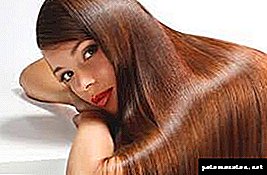 normal (with moderate secretion of sebum),
normal (with moderate secretion of sebum),- fatty (increased secretion of the sebaceous glands),
- dry (sebaceous excretion is poor),
- mixed type.
Each of the options suggests its own care, characteristic problems and ways to solve them. Basically, the oily hair and skin are the same, due to genetic predisposition and age parameters.
Normal hair
Owners of normal hair type oily skin is moderate, so that such a problem as peeling is extremely rare. If the hair is healthy, then they are elastic, most often quite thick, have a healthy shine and shimmer in the sun. Since the secretion of the sebaceous glands is not very active, the strands appear frequent for several days after washing the head.
This type of hair does not require special care. As for the characteristic problems, such troubles as a section of the tips almost never occur, the curls can be easily combed, do not break when twisting, easily fit into the hairstyle and keep their shape well when twisting. As for dandruff, it also occurs infrequently, as a rule, the scalp is clean.
Mixed hair
The mixed type includes hair, the tips of which are prone to dryness, and the roots, on the contrary, quickly become fat. After you have washed your head, the roots look normal, but the fat on them accumulates in 2-3 days. And although the scalp does not "tighten" the hair after washing, the ends of the hair are still dry and brittle, often pushing. Such hair will become fat for 3-4 days.
We recommend that you additionally take the test to be sure of your findings and get tips on caring for your hair type.
How often do you have to wash your hair to keep it clean and tidy?
- a) enough 2-3 times a week
Assess the condition of your hair ends:
- a) healthy or there is a small cut
- b) dry, hard brittle and split
- c) do not split
- d) split and break
What are your hair roots?
- a) moderately oily, become dirty in 2-3 days
- b) dry immediately after washing, after about a week they get a little fat
- c) normal, every other day fat
- d) after washing, fresh and clean, after 3 days they become greasy, but the tips remain dry
Look at your hair in good light, better in sunlight, do they shine?
- a) yes, shine is hair shimmer in the sun
- b) the shine is barely noticeable, the hair is dull
- c) the hair shines after washing the hair, but the next day a “greasy” shine appears
- d) the hair shines at the roots, and the tips are dull, almost not shine
How well does your hair retain moisture? Watch how your hair dries after washing and select the appropriate answer:
- a) hair after washing for a long time to dry
- b) the hair almost immediately becomes dry, especially quickly dry hair ends
- c) hair after washing hair dries moderately
- d) the ends of the hair dry up first, and the roots remain wet for a relatively long time
Do you use a hairdryer, straightening irons or curling irons?
- a) yes, hair does not suffer from it
- b) very rarely, the hair after that split, break and dry up even more
- c) I try not to use the hair dryer, the roots of this even more foul
- d) try not to use, the tips are dry and brittle
Is your hair electrified?
- a) almost never
- b) often, especially in winter
- c) can, but very rarely
- d) tips only
How lush is your hair?
- a) moderately lush
- b) very lush, you can say "fly away"
- c) immediately after washing is fluffy, every other day the hair loses its volume and begins to stick together
- d) the roots are lush, and the tips are pushed
If you counted more answers by the letter A, then you can be congratulated - you have a normal hair type. To maintain the health of your hair, you only need to do a mask for hair 1-2 times a week.
More answers under the letter B - you have a dry hair type. You need to revise your hair care, provide hair nutrition and protection.
More answer options B - you have oily hair. You need to carry out a set of procedures to bring your oily hair in order.
More answer options G - you have a mixed type of hair. You should pay more attention to your dry and damaged hair ends.
In general, the oily hair corresponds to the type of skin: if the skin is dry, dry hair grows on it, oily hair grows on oily skin.
Hair types: normal hair
Normal skin is moderately oily and does not peel off. Healthy normal hair is elastic, fairly thick and not thin. They reflect light well, have a healthy glow, shimmer in the sun. These qualities persist for several days after shampooing.
Normal hair is easy to care for. They barely split, easily combed both in wet and dry condition. Even with repeated twisting, such hair does not break, but immediately restores its original shape and easily fits into any hairstyle.
The scalp is clean, without dandruff and itching.
Hair types: dry hair
Dry skin often chapped, irritated and flaky. Dry hair is much thinner than normal, very sensitive to the effects of weathering, chemical and cosmetic products. Due to the reduced secretion of scalp dry hair loses its luster and elasticity, becomes dull and brittle, often reminiscent of artificial. Dry dandruff often appears on the scalp, which, when combed, is deposited on clothing in the form of light dust.
Such hair is difficult to lay after washing, they are difficult to comb, easily confused, broken and split at the ends. 1-2 days after washing your head, dry fine dandruff may appear.
Dry hair can be not only a consequence of reduced activity of the sebaceous glands, but also the result of improper care. With this type of hair, it is necessary to avoid procedures that lead to their drying (dyeing with chemical dyes, perming, brightening, exposure to direct sunlight, etc.).
Hair often becomes dry with age, replacing normal hair. This is due to excessive washing, the use of a hot hair dryer, the sun, fluctuations in air temperature, as well as health.
If your hair has become dull and brittle, then it means that you need to properly deal with your health.
To acquire elasticity and shine, dry hair needs additional nutrition, which activates blood circulation, normalizes fat metabolism and restores hair elasticity. It is useful to make compresses and masks of various vegetable oils (olive, soybean, castor, burdock, peppermint, jasmine, etc.).
Hair types: greasy hair
Oily skin is covered with a thicker layer of sebum and has a specific oily sheen, it has enlarged pores. Oily hair is also covered with grease, it is flexible and less water-absorbing than normal, has a characteristic dull shine, after a short time after washing it sticks together and begins to seem dirty and untidy.
Oily hair is the result of increased activity of the sebaceous glands of the scalp. To some extent, the amount of sebum produced depends on the type of food and the amount of carbohydrates (first of all) and fats consumed from food. When caring for oily hair, you need to follow a low fat diet - it helps normalize the endocrine system.
Violations of the activity of the sebaceous glands can be associated with diseases of the nervous system, hormonal disorders, taking certain medications, and poor nutrition.
Oily hair is usually found in young people, but they may also have older people. Without special care, they have a characteristic dull shine, after a short time after washing (2-3 days, even a few hours) lose their fluffiness, stick together and stick together in separate strands, hang in icicles and begin to look untidy.
Excess sebum is deposited on the skin of the scalp in the form of flakes or yellowish crusts that cause itching. Therefore, oily hair is often combined with oily dandruff.
Doctor about hair types
Svetlana Volbin
Dermatovenereologist of the first qualification category
Knowledge of your hair type is the basis of successful care. Improperly selected cosmetics will only worsen the condition of the hair.
There are 4 types of hair: normal, dry, oily and mixed (dry at the ends and oily at the roots).
When selecting cosmetics, the hair is further differentiated into thin and thick, depleted and healthy. The type of hair can vary slightly depending on the state of health, climate, care and become drier or oily, healthier or depleted. To determine your hair type, you only need to observe how often you have to wash your hair, how much your hair shines, if it gets greasy at the roots, or if there are dry tips.
If you have a normal type of hair, they are elastic, have a healthy shine, you can comb them easily and they are not prone to cross-section, such hair does not cause trouble, but brings only pleasure.
Dry hair is brittle, it has split ends, it is difficult to comb. Most often, this condition of the hair is due to improper care: frequent staining, the use of various chemical agents for smoothing, curling hair, etc. If you do not cover your hair in the open sun, then you have every chance to notice their dryness and dullness soon. The reason may be the physiological characteristics of the organism.
Oily hair has an unhealthy oily sheen. Hair often stick together and quickly dirty. The reason for the oily hair - increased secretion of the sebaceous glands of the scalp.
Often there is a mixed type, which is typical for long hair. As a rule, they are greasy at the roots of the hair and dry at the tips. But it must be remembered that dry ends of hair appear with age: the older the hair, the thinner and drier its ends. If you find it difficult to determine the type of hair yourself, you should consult a specialist.
Each hair type has its drawbacks and advantages. Oily hair may look more healthy and shiny, even if it is a short time. In addition, this type of hair is less susceptible to age-related changes.
Dry hair does not require frequent washing and stay clean longer. The disadvantages of dry hair are that they split at the ends, which can look dull and lifeless. If the scalp is very dry, dry fine dandruff may occur. Dry hair is not given by nature. They become such as the result of abuse of cosmetic procedures (styling ironing, hairdryer, after perm, dyeing) or due to improper care.
Care for different types of hair
On shampoos, we often see the inscription that they are intended for normal or dry or greasy hair. Indeed, hair comes in 4 types: normal, oily, dry and mixed. The fat content of the hair is due to the enhanced work of the sebaceous glands, which are located near the hair follicle. Sebum spreads over the entire surface of the hair, covering them with a film. And dirt and dust stick to the greasy film faster. Therefore, greasy hair should be washed more often than dry hair in order to weaken the excessive activity of the sebaceous glands.
Dry hair is brittle, dull, gradually losing its color and elasticity. Often dandruff appears on dry hair. Dry hair should be systematically trimmed to remove split ends, otherwise, they are cut further, acquiring an unhealthy appearance.
Often the condition of the skin and hair is unequal: the scalp is excessively oily, while the hair is dry. This is due to too frequent washing, which dehydrates the hair.
When skin and hair are dry, warm vegetable oil treatment is recommended. Oil covers the entire surface of the skin and hair, preventing the evaporation of water, and thereby restores the natural moisture. Heated olive oil rubbed into the base
hair, then wrap the head with a towel, an hour later the oil is washed off. Dry hair must be protected from the sun by a headdress, as from ultraviolet rays they become brittle and lose their color.
Mixed-type hair is distinguished by its fat content at the base, but by dryness and brittleness at the ends. This may be due to excessively diligent washing, as well as the result of improper selection of shampoo.
Oily hair - oily hair care
It is necessary to wash greasy hair once every 4-5 days. After washing the hair is rinsed with clean water. Water for washing oily hair should not be too hot (40-45 ° C).
- Hair can be rinsed with kvass diluted with water (1: 1).
- The skin becomes drier if excessively oily hair is rinsed after washing with an infusion of herbs from a mother and stepmother, nettle, plantain, St. John's wort. Each component must be taken 1 tablespoon, pour 1/2 liter of boiling water, insist 20-30 minutes in a sealed container and strain.
- Before washing your hair, it is useful to brush with kefir or yogurt and tie it with a towel for 15-20 minutes.
- Hair will become less greasy if you wash them once every 5-7 days for 2 months, rinsing in broth from oak bark. 3 tablespoons of oak bark pour 1 liter of water and boil for 15 minutes. The cooled and filtered decoction is used as water for washing.
- Oily scalp is useful to wipe 2-3 times a week tincture of calendula.
- It is also recommended to use an infusion of tansy: 1 tablespoon finely chopped stems and flowers pour 2 cups of boiling water and leave for 2 hours. Strained broth rubbed into the hair roots every other day for a month.
- If the hair becomes greasy after 2-3 days, it is necessary to wipe the scalp with the following composition: 5% boric acid solution, lemon juice and alcohol (1: 1: 1).
- Useful decoction of horsetail: 2 tablespoons of horsetail pour 1 liter of boiling water, simmer for 10 minutes, insist 15-20 minutes, then filter.
- In order for hair to become less greasy, it is recommended to rub bran, flour, powder, dry shampoo into the scalp. Flour or powder is removed with a brush, and hair is rubbed with a dry towel.
- To quickly wash your hair, you can rub potato starch into your hair. Then a couple of minutes should massage the scalp. After 5-10 minutes, rub your hair with a dry towel. Remove starch residue with a brush.
Dry hair - care for dry hair
Frequent washing dries the hair, so long dry hair is recommended to wash 1 time in 2-3 weeks, and short - 1 time in 10-12 days. After washing dry hair they should be rinsed with plenty of water. Water should be soft. If there is no soft water, then boric acid can be added to ordinary water (½ teaspoon of acid per liter of water). You can boil ordinary water, after which it becomes softer. It is recommended to wash the hair with rain or melt water.
- Before washing dry hair, for 45-60 minutes, it is necessary to apply a nourishing cream on them.
You can brush your hair with castor, almond or olive oil.
- Sour milk - an old folk remedy for washing hair. Currently, the head is also washed with yogurt, kefir, whey. Lactic acid products create a dense fatty film that protects hair from damage with alkaline soap and water.
- You can take sour milk, wet your head profusely, cover it with a polyethylene scarf, and above with a terry towel. After 25-30 minutes, rinse the hair, rinse thoroughly with just warm and then acidified water (juice of 1 lemon or 1 tablespoon of vinegar in 2 liters of water).
How often can you wash your hair?
No one will give you an exact answer. It all depends on the rate of contamination and the use of varnishes and gels. Some people wash their heads daily, others only once a week. To decide only you.
In stores you can choose a different number of masks, shampoos and conditioners. They differ in composition, price, quality. Designed for different types of hair. The choice is an individual matter. Masks should be applied no more than 1 time per week for 15–20 minutes.
If you for some reason do not trust the purchased masks, you can do them yourself at home. Hand-made masks are more natural and do not cause allergic reactions. Home masks are also used for different purposes.
Mask to nourish and moisturize hair
You need to take 1 spoon of cocoa powder, yolk, half a cup of kefir. All components mix, put the mixture on his head and leave for an hour, then rinse.
There are many recipes for hair masks, the choice is yours. Remember, you need to care for your hair all the time, and they will thank you with their healthy and beautiful shine.
A simple test: how to determine your hair type
- a) every 3-4 days
- b) once in 5-7 days,
- c) the next day the strands stick together in icicles,
- d) in 2-3 days.
- a) there are practically no split tips,
- b) a solid problem - dry, split and broken,
- c) do not split at all,
- d) split and break.
- a) moderate fatness - they begin to dirty themselves for 2-3 days,
- b) dry tips, get fat only in a week,
- c) normal, they begin to get dirty in a day,
- g) noticeably get fat only after 3-4 days after washing, but the tips are still dry.
- a) shine and shimmer in the sun
- b) is generally not very shiny, dull,
- c) the hair shines, but a day after washing the shine becomes unpleasant - hair is greasy,
- g) shine is, but only at the roots - the tips are dry and dull.
- a) dry for a long time
- b) dry quickly especially the tips,
- c) dry moderately
- d) the tips first dry out and the roots are still wet for a long time.
- a) yes, I use a hairdryer, curling iron or ironing, but my hair does not suffer,
- b) I use a hairdryer, curling iron or ironing, but rarely, because hair is very dry,
- c) I try to dry naturally, as the hair becomes greasy even faster,
- d) the tips are already dry, and after drying with a hairdryer they generally fall off.
- a) almost do not face such a problem
- b) especially in winter
- c) only occasionally
- d) only the tips.
- a) lush but moderately
- b) very lush,
- c) lush only after washing, the very next day they stick together in icicles,
- g) the volume is only at the roots, and the tips are lifeless.
A large number of responses under the letter A indicates a normal type of hair. As a care, it is proposed to make supporting and vitamin masks 1-2 times a week.
If the letter B prevails in the responses, then the dry type can be identified. This hair needs moisturizing and nourishing masks and gentle care.
If most of the answers are the letter B, the curls are bold. Complex procedures with oils to normalize the secretion of the sebaceous glands will help bring your hair in order.
Answers under the letter G speak of a mixed type of hair. It is worth paying attention to both dry ends and fat roots - this allows you to provide optimal care and make the hair beautiful.
Type Test
 Determining your own hair type is not difficult if you follow practical recommendations. First you need to test for fat, so you need to prepare a paper towel or napkin in advance. Strands should be shampooed several times, but you should not apply a balm or conditioner. Then blot with a towel and leave at room temperature until dry.
Determining your own hair type is not difficult if you follow practical recommendations. First you need to test for fat, so you need to prepare a paper towel or napkin in advance. Strands should be shampooed several times, but you should not apply a balm or conditioner. Then blot with a towel and leave at room temperature until dry.
When drying it is impossible to use the hair dryer - it is necessary for the most accurate identification of the result. Strands should dry naturally. Next, you need to take parchment paper or paper towel. The edge of the product should be pressed to the scalp in the area of the crown, the other edge should be brought to the area behind the ears. You need to wait 10 seconds, then evaluate the result.
If there are greasy inclusions on the napkin, the curls are referred to as fat type. This is evidenced by the accelerated production of subcutaneous fat immediately after cleansing the hair. In the case when the strands are normal, combined or dry, then there will be no stains on the towel. The girl will have to determine the type based on personal observations and general characteristics.
Oily, dry and normal hair
To more correctly determine what type of curls are, you need to follow certain rules. Determination of dry hair type:
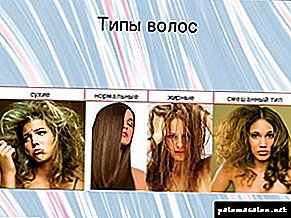 The tips are dry to the touch, split and break.
The tips are dry to the touch, split and break.- Hair looks dirty, requires washing every six days.
- The hair strands are dull, lacking shine, the shade is poorly visible.
- Strands are often subject to a static effect or a fur.
- Dry strands are naughty, they are difficult to put in the hair.
- After each wash the skin is tightened.
- Blow-drying makes the hair fragile and at the same time inanimate.
Fatty type strands:
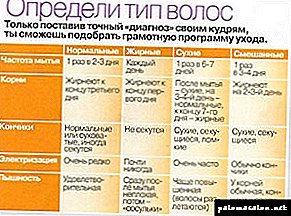 The tips are not dry at the ends, there is no breakage and no section.
The tips are not dry at the ends, there is no breakage and no section.- Strands of this type are easy to assemble into a hairstyle, but it quickly disintegrates.
- After applying the hair dryer there is no static effect.
- The hair does not push, any styling is well preserved.
- After washing the curls there is no skin tightness.
- The fat type is distinguished by an ugly shine.
- Curls quickly dirty, for a short period of time begin to look untidy.
- Strands seem greasy a day after washing.
Curls of the normal type:
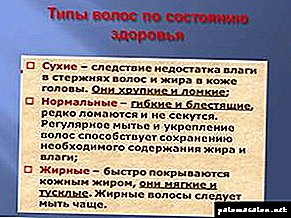 Shampooing is done once a day, while at the end of this time interval the strands look greasy.
Shampooing is done once a day, while at the end of this time interval the strands look greasy.- When drying a hair dryer curls a little fuzz, but they are soft to the touch.
- In rare cases, after washing the hair appears tightness of the skin.
- Strands are easily assembled into any styling or hairstyle.
- Very rarely, the ends split and appear dry.
- During the day after washing the strands shine beautifully.
Combined type strands:
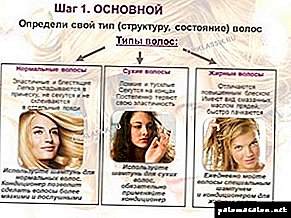 Three days after washing, the hair becomes oily in the root area, the ends of the hair lose their shine.
Three days after washing, the hair becomes oily in the root area, the ends of the hair lose their shine.- After applying the hair dryer, the tips are pushed and become naughty.
- Hair must be given a basal volume, all other styling attempts remain unsuccessful.
- The static effect applies only to the tips.
- Sometimes skin is exposed to tightness.
- After shampooing, strands become dirty for 4 days and become greasy.
- Curls along the entire length retain a pleasant shine for three days.
- Ends split, break and have dryness.
Strand care
After the girl has decided on the type, you need to choose the appropriate basic care. For different types it is selected individually.
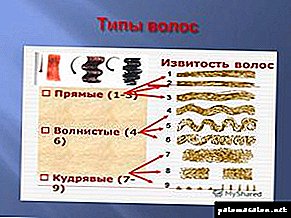 Dry strands. For this type of curls, you need to select a cleansing shampoo with a cream or transparent texture. Cosmetics of this kind creates auxiliary protection. Strands need to be saturated with moisture, rinsed with chamomile decoction. Every day it is necessary to rub vitamin E in capsules into the skin, it can be purchased at the pharmacy. No need to go to bed with wet hair. It is necessary to abandon styling curling, ironing or hairdryer.
Dry strands. For this type of curls, you need to select a cleansing shampoo with a cream or transparent texture. Cosmetics of this kind creates auxiliary protection. Strands need to be saturated with moisture, rinsed with chamomile decoction. Every day it is necessary to rub vitamin E in capsules into the skin, it can be purchased at the pharmacy. No need to go to bed with wet hair. It is necessary to abandon styling curling, ironing or hairdryer.
Do not use sticky curlers. After each use of the shampoo, apply a balm and spray the strands with a spray-conditioner, or rub in an indelible grooming serum. Twice a week, rub into the scalp and distribute burdock or coconut oil over the entire length of the curls. It helps to restore hair shine and elasticity, prevents their section.
 Greasy curls. You need to try not to expose strands to heat. You need to wash your hair with a little warm water so as not to provoke an accelerated sebum secretion. It is necessary to apply shampoos for fat type of curls. You need to choose a balm from the same series, but with a light texture. Spinning should be dried with a hairdryer only in rare cases.
Greasy curls. You need to try not to expose strands to heat. You need to wash your hair with a little warm water so as not to provoke an accelerated sebum secretion. It is necessary to apply shampoos for fat type of curls. You need to choose a balm from the same series, but with a light texture. Spinning should be dried with a hairdryer only in rare cases.
Hair need to make masks to normalize the activity of the sebaceous glands. The mask should include brewer's yeast, honey, vodka, white or blue clay and chicken yolk. Once every two days it is necessary to rinse the strands with medicinal decoction. It can be made from chamomile, thyme, plantain, nettle or mint.
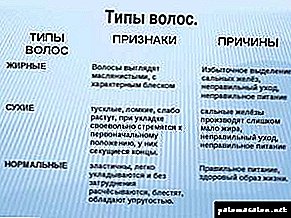 Combined and normal strands. Combing the curls should be a wooden comb or a massage brush with a natural bristle. Hair dryer should be used only in emergency situations. Twice a month it is necessary to clean the sebaceous ducts with a scrub. It can be made at home from balsam and crushed apricot kernels, sea salt or coffee grounds. You should wash your hair no more than once every three days. You need to use shampoos, which include keratin.
Combined and normal strands. Combing the curls should be a wooden comb or a massage brush with a natural bristle. Hair dryer should be used only in emergency situations. Twice a month it is necessary to clean the sebaceous ducts with a scrub. It can be made at home from balsam and crushed apricot kernels, sea salt or coffee grounds. You should wash your hair no more than once every three days. You need to use shampoos, which include keratin.
Hair structure
When choosing care products for curls, hairstyles and styling, as well as the shape of a haircut, many women are guided not only by personal preferences, but also by the thickness, type, and level of hair stiffness. Different nationalities strands differ in structure, shape, volume and thickness. For example, black, curly and thick hair are characteristic of the Negroid race. Aryans have blond hair. But the most durable and thick hair - red. The life cycle of curls consists of 3 stages:
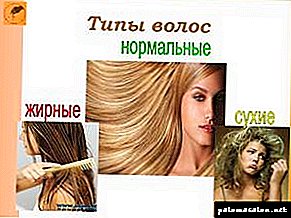 Anagen. At this time, an increased division of the cells occurs in the hair follicle, during which the subsequent ones push the previous ones, and a new hair shaft is created.
Anagen. At this time, an increased division of the cells occurs in the hair follicle, during which the subsequent ones push the previous ones, and a new hair shaft is created.- Catagen. The hair follicle crosses during fading activity, at which time the bulb of the strand falls away from the follicle.
- Telogen. The production of cells stops until a new bulb is created.
This process can occur from 2 to 5 years. It all depends on genetic predisposition, human health and the environment. On the scalp of an average person is up to 150,000 follicles. Each of them is programmed to produce 26 or 28 bulbs. On average, loss of up to 80 hairs is considered normal. Human hair consists of the following:
- Hair follicle. It covers the network of blood vessels. It is the root of a hair attached to the papilla of the hair follicle.
- Kernel. It is the result of the division of living cells.
The follicle is surrounded by muscles, tissues, it holds strands and sebaceous glands. Each person is born with an established set of follicles, the number of which is programmed at the genetic level.
Division into groups
There are four main hair groups, including the following:
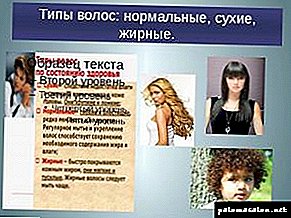 Damaged curls. Such strands were spoiled during intensive use of chemical dyes. This includes dry or oily hair.
Damaged curls. Such strands were spoiled during intensive use of chemical dyes. This includes dry or oily hair.- Thin, damaged and loose strands that need special care.
- Heavy strands. These curls have great weight, which is associated with a high thickness of hairs. They have a silky and brilliant look, the hair shape of this group is special, it has a core.
- Strands of moderate severity. Curls are the same as in the previous group, the characteristic is not much different from the previous one.
The color of the hair is divided into five types of hair in women:
- Black - brunet.
- Brown, closer to chocolate - brown.
- Brown, close to a red shade - chestnut.
- Light strands with an ash tint - platinum blond.
- Bright curls - blond.
Hair is distributed by properties:
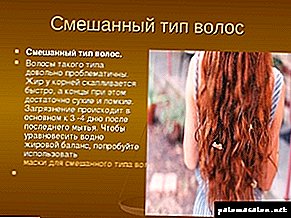 Electrical conductivity This property explains the ability to electrify curls.
Electrical conductivity This property explains the ability to electrify curls.- Grain. This property depends on the number of voids in the curl structure. With age, grit hair increases. The higher the grain, the lighter and thinner the hair.
- Hygroscopicity. This property determines the ability of strands to evaporate and absorb moisture.
- Strength. This category determines the ability of the locks to resist mechanical stress.
- Stiffness and thickness. Hair can be thick, glassy or thin.
- Elasticity or elasticity. This property includes the ability of the curl to stretch. The indicator changes in the event that the strands wet. In cold water, this capacity increases, while in hot water it decreases.
Characteristics of curls
Before using the product to care for curls, chemical treatment or exposure to thermal styling you need to know what types of strands on the human head are in structure, as well as their main characteristics. The curl structure and description are as follows:
 Normal curls with a stable secretion of fat.
Normal curls with a stable secretion of fat.- Fatty curls with copious sebaceous excretions.
- Dry with minimal sebum secretion.
- Combined strands with normal sebum.
Each individual type requires special care. The simplest is to care for a mixed type of curls. Here the main thing - to know the type of skin, to adhere to its main characteristics. Determine the type of curls can be on the skin, if the scalp is oily, then the strands will be appropriate. Characteristic:
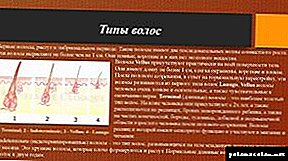 Normal strands with stable sebaceous excretions. The main difference of normal hair lies in their average thickness, thickness and stiffness. They perfectly reflect the sun's rays, have brilliance and a healthy look. This is noticeable for several days after cleansing the strands. The main advantage of the normal type of curls - it is easy to care. They are easy to comb after rinsing, they do not have split ends.
Normal strands with stable sebaceous excretions. The main difference of normal hair lies in their average thickness, thickness and stiffness. They perfectly reflect the sun's rays, have brilliance and a healthy look. This is noticeable for several days after cleansing the strands. The main advantage of the normal type of curls - it is easy to care. They are easy to comb after rinsing, they do not have split ends.- Dry curls with different types of sebaceous excretions. The structure of such hair is characterized by the fact that the hair shaft is thin and has an increased sensitivity to changes in external influence. Low sebum secretion has a bad effect on the natural luster and elasticity of the curls. They are more likely to be brittle and dry. If you do not properly care for such hair, then over time they will become like artificial.
- Fatty locks with increased sebum secretion. This type of hair is covered with a protective fat coat. They are much stronger and more elastic than curls of other types. But the shine of these strands is dull. Shortly after washing, the hair becomes fat and looks like unwashed and dirty. With this type of hair should follow a diet that includes foods with low fat content.
- Mixed type of curls with normal sebaceous excretions. These strands are oily at the base, but dry at the ends. This is because the lubricant is not distributed over the entire length of the curls. As a rule, strands of this type are prone to cross-section at the tips. Care for them is necessary with the help of special tools.
 Many women look in the mirror, not thinking about how beauty manifests itself from within. Having learned what structure has hair, what factors influence its health and beauty, one can understand how to properly preserve the natural beauty of the hair and correct deficiencies. Knowing the groups and types of curls, you can choose the right means to care for the tips and roots of hair. As curls can be judged on the health of the human body as a whole.
Many women look in the mirror, not thinking about how beauty manifests itself from within. Having learned what structure has hair, what factors influence its health and beauty, one can understand how to properly preserve the natural beauty of the hair and correct deficiencies. Knowing the groups and types of curls, you can choose the right means to care for the tips and roots of hair. As curls can be judged on the health of the human body as a whole.

 normal (with moderate secretion of sebum),
normal (with moderate secretion of sebum), The tips are dry to the touch, split and break.
The tips are dry to the touch, split and break. The tips are not dry at the ends, there is no breakage and no section.
The tips are not dry at the ends, there is no breakage and no section. Shampooing is done once a day, while at the end of this time interval the strands look greasy.
Shampooing is done once a day, while at the end of this time interval the strands look greasy. Three days after washing, the hair becomes oily in the root area, the ends of the hair lose their shine.
Three days after washing, the hair becomes oily in the root area, the ends of the hair lose their shine. Dry strands. For this type of curls, you need to select a cleansing shampoo with a cream or transparent texture. Cosmetics of this kind creates auxiliary protection. Strands need to be saturated with moisture, rinsed with chamomile decoction. Every day it is necessary to rub vitamin E in capsules into the skin, it can be purchased at the pharmacy. No need to go to bed with wet hair. It is necessary to abandon styling curling, ironing or hairdryer.
Dry strands. For this type of curls, you need to select a cleansing shampoo with a cream or transparent texture. Cosmetics of this kind creates auxiliary protection. Strands need to be saturated with moisture, rinsed with chamomile decoction. Every day it is necessary to rub vitamin E in capsules into the skin, it can be purchased at the pharmacy. No need to go to bed with wet hair. It is necessary to abandon styling curling, ironing or hairdryer. Greasy curls. You need to try not to expose strands to heat. You need to wash your hair with a little warm water so as not to provoke an accelerated sebum secretion. It is necessary to apply shampoos for fat type of curls. You need to choose a balm from the same series, but with a light texture. Spinning should be dried with a hairdryer only in rare cases.
Greasy curls. You need to try not to expose strands to heat. You need to wash your hair with a little warm water so as not to provoke an accelerated sebum secretion. It is necessary to apply shampoos for fat type of curls. You need to choose a balm from the same series, but with a light texture. Spinning should be dried with a hairdryer only in rare cases. Combined and normal strands. Combing the curls should be a wooden comb or a massage brush with a natural bristle. Hair dryer should be used only in emergency situations. Twice a month it is necessary to clean the sebaceous ducts with a scrub. It can be made at home from balsam and crushed apricot kernels, sea salt or coffee grounds. You should wash your hair no more than once every three days. You need to use shampoos, which include keratin.
Combined and normal strands. Combing the curls should be a wooden comb or a massage brush with a natural bristle. Hair dryer should be used only in emergency situations. Twice a month it is necessary to clean the sebaceous ducts with a scrub. It can be made at home from balsam and crushed apricot kernels, sea salt or coffee grounds. You should wash your hair no more than once every three days. You need to use shampoos, which include keratin. Anagen. At this time, an increased division of the cells occurs in the hair follicle, during which the subsequent ones push the previous ones, and a new hair shaft is created.
Anagen. At this time, an increased division of the cells occurs in the hair follicle, during which the subsequent ones push the previous ones, and a new hair shaft is created. Damaged curls. Such strands were spoiled during intensive use of chemical dyes. This includes dry or oily hair.
Damaged curls. Such strands were spoiled during intensive use of chemical dyes. This includes dry or oily hair. Electrical conductivity This property explains the ability to electrify curls.
Electrical conductivity This property explains the ability to electrify curls. Normal curls with a stable secretion of fat.
Normal curls with a stable secretion of fat. Normal strands with stable sebaceous excretions. The main difference of normal hair lies in their average thickness, thickness and stiffness. They perfectly reflect the sun's rays, have brilliance and a healthy look. This is noticeable for several days after cleansing the strands. The main advantage of the normal type of curls - it is easy to care. They are easy to comb after rinsing, they do not have split ends.
Normal strands with stable sebaceous excretions. The main difference of normal hair lies in their average thickness, thickness and stiffness. They perfectly reflect the sun's rays, have brilliance and a healthy look. This is noticeable for several days after cleansing the strands. The main advantage of the normal type of curls - it is easy to care. They are easy to comb after rinsing, they do not have split ends.
